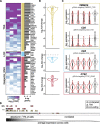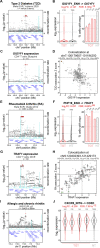Mapping the functional impact of non-coding regulatory elements in primary T cells through single-cell CRISPR screens
- PMID: 38308274
- PMCID: PMC10835965
- DOI: 10.1186/s13059-024-03176-z
Mapping the functional impact of non-coding regulatory elements in primary T cells through single-cell CRISPR screens
Abstract
Background: Drug targets with genetic evidence are expected to increase clinical success by at least twofold. Yet, translating disease-associated genetic variants into functional knowledge remains a fundamental challenge of drug discovery. A key issue is that the vast majority of complex disease associations cannot be cleanly mapped to a gene. Immune disease-associated variants are enriched within regulatory elements found in T-cell-specific open chromatin regions.
Results: To identify genes and molecular programs modulated by these regulatory elements, we develop a CRISPRi-based single-cell functional screening approach in primary human T cells. Our pipeline enables the interrogation of transcriptomic changes induced by the perturbation of regulatory elements at scale. We first optimize an efficient CRISPRi protocol in primary CD4+ T cells via CROPseq vectors. Subsequently, we perform a screen targeting 45 non-coding regulatory elements and 35 transcription start sites and profile approximately 250,000 T -cell single-cell transcriptomes. We develop a bespoke analytical pipeline for element-to-gene (E2G) mapping and demonstrate that our method can identify both previously annotated and novel E2G links. Lastly, we integrate genetic association data for immune-related traits and demonstrate how our platform can aid in the identification of effector genes for GWAS loci.
Conclusions: We describe "primary T cell crisprQTL" - a scalable, single-cell functional genomics approach for mapping regulatory elements to genes in primary human T cells. We show how this framework can facilitate the interrogation of immune disease GWAS hits and propose that the combination of experimental and QTL-based techniques is likely to address the variant-to-function problem.
Keywords: CRISPR; CROPseq; Enhancer; GWAS; Regulatory element; T cells; Variant to function; crisprQTL; scRNA-seq.
© 2024. The Author(s).
Conflict of interest statement
C. A.-C., X. I.-S., C. F., J. E.-G., D. H., A. H., B. S., W. P., S. U., A. C., A. A., S. M., C. F., G. D., and R. R. are employees at GlaxoSmithKline. A. K. is an employee at Myllia Biotechnology.
Figures






Similar articles
-
A Genome-wide Framework for Mapping Gene Regulation via Cellular Genetic Screens.Cell. 2019 Jan 10;176(1-2):377-390.e19. doi: 10.1016/j.cell.2018.11.029. Epub 2019 Jan 3. Cell. 2019. PMID: 30612741 Free PMC article.
-
Mapping cis-regulatory chromatin contacts in neural cells links neuropsychiatric disorder risk variants to target genes.Nat Genet. 2019 Aug;51(8):1252-1262. doi: 10.1038/s41588-019-0472-1. Epub 2019 Jul 31. Nat Genet. 2019. PMID: 31367015 Free PMC article.
-
High-resolution genetic mapping of putative causal interactions between regions of open chromatin.Nat Genet. 2019 Jan;51(1):128-137. doi: 10.1038/s41588-018-0278-6. Epub 2018 Nov 26. Nat Genet. 2019. PMID: 30478436 Free PMC article.
-
Regulatory variants: from detection to predicting impact.Brief Bioinform. 2019 Sep 27;20(5):1639-1654. doi: 10.1093/bib/bby039. Brief Bioinform. 2019. PMID: 29893792 Free PMC article. Review.
-
Translating non-coding genetic associations into a better understanding of immune-mediated disease.Dis Model Mech. 2023 Mar 1;16(3):dmm049790. doi: 10.1242/dmm.049790. Epub 2023 Mar 7. Dis Model Mech. 2023. PMID: 36897113 Free PMC article. Review.
Cited by
-
GWAS-Informed data integration and non-coding CRISPRi screen illuminate genetic etiology of bone mineral density.bioRxiv [Preprint]. 2024 Dec 29:2024.03.19.585778. doi: 10.1101/2024.03.19.585778. bioRxiv. 2024. PMID: 38562830 Free PMC article. Preprint.
-
Variants in tubule epithelial regulatory elements mediate most heritable differences in human kidney function.Nat Genet. 2024 Oct;56(10):2078-2092. doi: 10.1038/s41588-024-01904-6. Epub 2024 Sep 10. Nat Genet. 2024. PMID: 39256582
References
Publication types
MeSH terms
Substances
LinkOut - more resources
Full Text Sources
Medical
Research Materials

